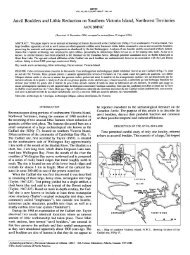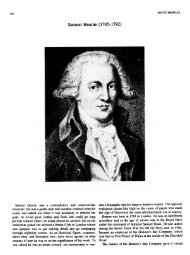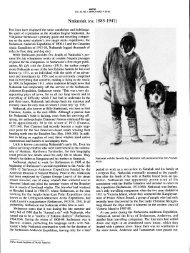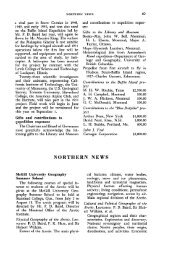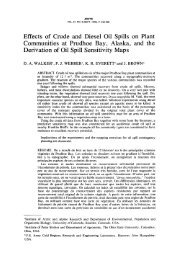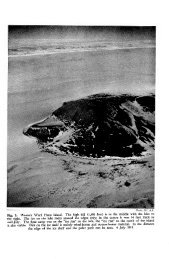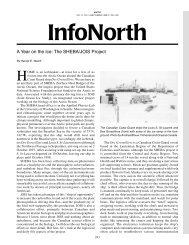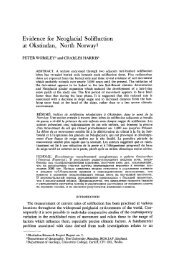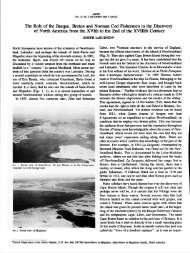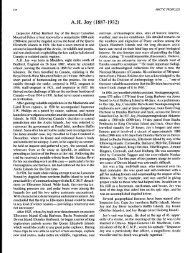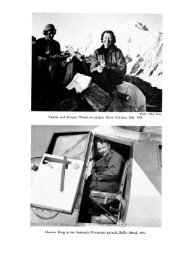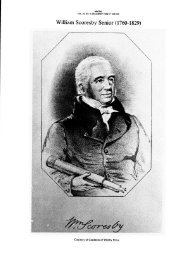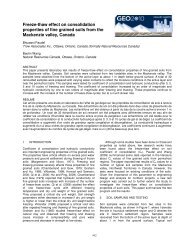NOTES ON THE NUNAMIUT ESKIMO AND MAMMALS OF ... - arctic
NOTES ON THE NUNAMIUT ESKIMO AND MAMMALS OF ... - arctic
NOTES ON THE NUNAMIUT ESKIMO AND MAMMALS OF ... - arctic
You also want an ePaper? Increase the reach of your titles
YUMPU automatically turns print PDFs into web optimized ePapers that Google loves.
<strong>THE</strong> <strong>NUNAMIUT</strong> <strong>ESKIMO</strong> <strong>AND</strong> <strong>MAMMALS</strong> <strong>OF</strong> <strong>THE</strong> ANAKTUVUK PASS REGI<strong>ON</strong> 15 1<br />
5, and 9) forms a passage of two to four miles in width across the Brooks<br />
Range and is an important migration route for various mammals and birds as<br />
well as for the Eskimo. There are many glacial-moraine lakes, alluvial terraces,<br />
and ground moraines on the valley floor, which, at the divide, reaches an<br />
altitude of about 2,000 feet only. Sand dunes occur in places along the<br />
Anaktuvuk River, Numerous creeks, dry except during the spring thaw,<br />
tumble in steep, rocky beds from the mountains into the valley. The Anaktuvuk<br />
enters the main valley from the east, at an altitude of about 2,500 feet<br />
and flows northward to the Colville, which in turn empties into the Arctic<br />
Ocean. The part of the Anaktuvuk lying to the east of the main valley is<br />
called by the Nunamiut Anaktiktoak.<br />
Brooks (1906, p. 102) has described the Anaktuvuk valley and pass: “This<br />
pass is only a few miles from where the range falls off to the piedmont plateau<br />
on the north, and the Anaktuvuk soon leaves the mountains. The intermontane<br />
part of its valley is wide, with abrupt walls, and is only about 15 miles in length,<br />
in which distance the river descends over 200 feet. Leaving the mountains,<br />
it enters a broad basin 40 miles in length, which has been incised in the<br />
Anaktuvuk Plateau and which receives several tributaries.” Schrader (1904)<br />
has discussed several features of this country.<br />
The John River enters the main valley from the west but a few miles<br />
south of the Anaktuvuk, and flows south to join the Koyukuk River, a<br />
tributary of the Yukon. The part of the John River which lies to the west<br />
of the main valley is called Nachamkunga (from genitive forms of nachrach,<br />
“divide”, and kook, “creek”) by the Nunamiut.<br />
In the main valley certain springs and seepages remain open throughout<br />
the winter. Tulugak Lake is fed by such springs, which maintain a temperature<br />
slightly above freezing all year. Open creeks are also found in the<br />
winter in the Savioyok valley. There are no glaciers in the Anaktuvuk Pass<br />
region, but some snowfields persist all summer. There is a considerable<br />
of Aufeis, or heavy ice deposits, in the Savioyok valley.<br />
area<br />
Climate<br />
Although in the winter some days are made unpleasant by severe winds<br />
from the north (the Koyukuk Indian name for the lower John River is<br />
Atchenak, “blowing hard”), the region is not excessively cold. The temper-<br />
ature rarely falls as low as -50°F. The annual precipitation is only a few<br />
inches. The spring and summer weather are delightful, with cool, clear days.<br />
On approaching timber, farther south, the precipitation increases rapidly,<br />
resulting in deep winter snows. This is also the case in the timbered Savioyok<br />
valley to the east; the change in amount of precipitation is very striking as<br />
soon as the divide near the head of Inukpasukruk Creek has been crossed, at<br />
an altitude of about 4,500 feet, and the descent started into the country drained<br />
by the North Fork.<br />
Since the generally sparse snow becomes firmly packed during the winter<br />
by the strong winds, the Anaktuvuk Pass country is very favourable for travel<br />
bv dog team. Snowshoes are often unnecessary, unless approaching the



